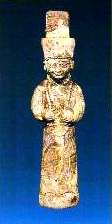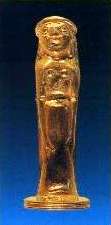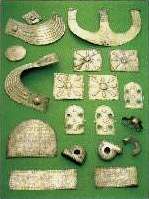As we try to assemble the facts we can tentatively establish about Lydian art, there are categories of uneven documentation that call for study. Excavations at Sardis have given us respect for Lydian architectural workmanship exemplified in the ashlar terrace walls of the acropolis) in the marble and limestone masonry of the tomb chamber of Alyattes under one of the largest tumuli, and in the Py'ramid Tomb near the lower city. A new study of the Lvdian contribution to Persian monumental architecture is in progress.
We cannot fathom the Lydian contribution to sculpture in marble and limestone, to sculptural form, image and style on the present evidence. The contact with Greek-lonian art is so strong in the 6th century' BC that the separation of original elements becomes difficult. The same applies to the terracotta revetments with relief design. In the latter category a lively exchange with Phrygian art is also evident.
|

Ivory priest figurine
(eunuch priest)
from the Artemision at Ephesos
7th century BC.
|

Gold female figurine found during excavations at the Artemision at Ephesos in 1993. 7th century BC. 5.15 cm in height and 51.8 gr.
|
In representational sculpture, the making of cult statues, reliefs and votives, we need to consider the possibility of a Bronze Age inheritance of western Anatolia. The Lydians, as noted by their language, are of Bronze Age Anatolian ancestry. Hittite historical references to Assuwa and Arzawa geographically include the territory of later Lvdia. The Arzawa region was inhabited by ambitious kings and followers who were in historical contact with the Hittite kings and occasionally with Egypt, as born out by the Arzawa letters in Amarna. Hirtite monuments were carved on the rocks of Lydia: a seated goddess on the northeast side of the Sipylos mountain (Wanisa Dagi), and a striding king or god at Karabel, some 30 kilometers south of Manisa. Lydian art could have had its roots in Bronze Age predecessors, which will have to be recognized as different from Hirtite art, whether major or minor. Seals, terracottas, metal figurines and ivory carvings are all potential categories of relevance to the search for Lydian sculptural roots.
There has long been an impression among observers of the minor arts from the Artemision at Ephesos that an old artistic idiom is surviving in the ivory carvings representing priests, worshippers, women in long robes, and votaries in general. The elements of this hypothetical old style are also embodied in lonian art and are among its distinctive hallmarks, especially in the facial features of some lonian marble statues and reliefs.
|
Recently, the excavation of an undisturbed tumulus in the Elmali plain near the village of Bayindir in northern Lycia has yielded ivories that carry the same Anatolian imprint, and are also related to the Ephesian series from the Artemision. A female figure in Anatolian costume, holding two children, a girl by her side and a nude boy on her shoulder belongs to a native Anatolian, non-Greek tradition which does not look Hittite. The context of the tomb is early 7th century BC, and the tomb and many of its contents display strong Phrygian affinities, but the ivories reveal a west Anatolian art made by members of a tradition of which the Lydians, neighbours of the north Lycian plain of Elmali, may have been the originators and carriers. Viewing this particular ivory we are close to the roots of west Anatolian art as it became known to the East Greeks as well as the Persians. Predecessors can be postulated, and may have circulated in the era when Arzawa was in correspondence with the Hittites and with Egypt, and in neighbourly contact with Aegean settlers on the coast of westem Anatolia.
The earliest major and minor sculptures from Sardis and the ivories from Ephesos as well as Bayindir appear to us in a fully developed, confident idiom promising the archaeologist and art historian that an investigation of relationships and originality vis-a-vis second millennium and proto-Lydian art may be rewarding.
|

Ivory figurine of a woman with two children,
Bayindir Tumulus D
7th century BC.
|

A group of silver objects from tumulus D
|
In the minor arts we face similar problems of tradition and innovation. The excellent craftsmanship in the making of gold jewellery is a typical outcome of a long tradition of collecting and refining gold from the Pactolos and the Tmolos mountains, starting perhaps in the Early Bronze Age from which there are samples of gold ear plugs from burials. The jewellery from Sardis is well represented in the Istanbul Museum collection of tomb gifts excavated in 1910-1914 on the west bank of the Pactolos; the parallels to the Usak material are evident, and the gold refinery-workshop area excavated on the east bank of the Pactolos gives evidence for the period C. 620-550 BC.
Among the most important items of personal jewellery in the Usak hoard, as well as in the general realm of the Lydian kingdom and elsewhere, are seal rings. These are appropriate tomb gifts indicating a status of responsibility; but it is likelythat seal rings were deposited in lesser tombs as well as in tumuli. Although these rings borrow traits from the Levanto-Egyptian scarab and scaraboid seal shapes and some are frankly Achaemenid in design, the basic association with Lydians is proved by the finds from the Pactolos West cemetery at Sardis. Unfortunately, however, we have no Lydian tomb context of early 7th century date to check the purest Lydian seal shapes for the days of Gyges and before his rule.
|
|











